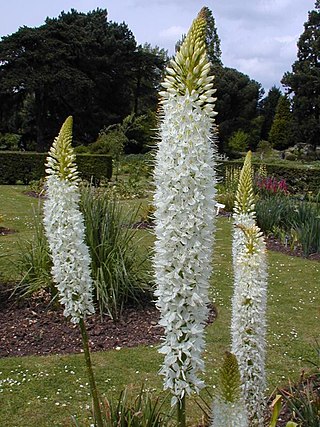
Tajikistan, officially the Republic of Tajikistan, is a landlocked country in Central Asia. Dushanbe is the capital and most populous city. Tajikistan is bordered by Afghanistan to the south, Uzbekistan to the west, Kyrgyzstan to the north, and China to the east. It is separated from Pakistan by Afghanistan's Wakhan Corridor.

Tajiks are a Persian-speaking Iranian ethnic group native to Central Asia, living primarily in Afghanistan, Tajikistan, and Uzbekistan. Tajiks are the largest ethnicity in Tajikistan, and the second-largest in Afghanistan and Uzbekistan. They speak varieties of Persian, a Western Iranian language. In Tajikistan, since the 1939 Soviet census, its small Pamiri and Yaghnobi ethnic groups are included as Tajiks. In China, the term is used to refer to its Pamiri ethnic groups, the Tajiks of Xinjiang, who speak the Eastern Iranian Pamiri languages. In Afghanistan, the Pamiris are counted as a separate ethnic group.

Alopecurus, or foxtail grass, is a common and widespread genus of plants in the grass family. It is common across temperate and subtropical parts of Eurasia, northern Africa, and the Americas, as well as naturalized in Australia and on various islands.
The Pamir languages are an areal group of the Eastern Iranian languages, spoken by numerous people in the Pamir Mountains, primarily along the Panj River and its tributaries.

Gagea is a large genus of spring flowers in the lily family. It is found primarily in Eurasia with a few species extending into North Africa and one species in North America.

Ixiolirion is a genus of flowering plants native to central and southwest Asia, first described as a genus in 1821. Recent classifications place the group in the monogeneric family Ixioliriaceae in the order Asparagales of the monocots. In earlier systems of classification, it was usually placed in the family Amaryllidaceae.

Iran–Tajikistan relations refer to the bilateral relations between Iran and Tajikistan. Since the collapse of the Soviet Union, the two countries have naturally enjoyed a close and strong relationship with the two often being described as "one spirit in two bodies" by the ex-president of Iran Mahmoud Ahmadinejad due to both being Persian-speaking and Iranic countries.

Lagochilus is a genus of the mint family that contains Turkistan mint.

Eremurus is a genus of deciduous perennial flowers in the family Asphodelaceae. They are also known as the foxtail lilies or desert candles. They are native to eastern Europe in, and temperate Asia from Turkey to China, with many species in Central Asia.

Eminium is a genus of flowering plants in the family Araceae. The genus ranges from Turkey and Egypt east to Central Asia. Usually they can be found growing in barren areas in sand or stony soil. The foliage of Eminium resembles Helicodiceros and its inflorescence and fruit resembles those of Biarum.
- Eminium albertii(Regel) Engl. - Turkmenistan, Uzbekistan, Afghanistan
- Eminium heterophyllum(Blume) Schott - Iran, Iraq, Turkey
- Eminium intortum(Banks & Sol.) Kuntze - Turkey, Syria
- Eminium jaegeriBogner & P.C.Boyce - Iran
- Eminium koenenianumLobin & P.C.Boyce - Turkey
- Eminium lehmannii(Bunge) Kuntze - Kazakhstan, Kyrgyzstan, Turkmenistan, Uzbekistan, Afghanistan, Tajikistan
- Eminium rauwolffii(Blume) Schott - Turkey, Syria
- Eminium regeliiVved. - Kazakhstan, Kyrgyzstan, Tajikistan, Uzbekistan
- Eminium spiculatum(Blume) Schott - Egypt, Israel, Palestine, Jordan, Lebanon, Syria, Iraq, Iran

Sangtuda 1 Hydroelectric Power Plant is a hydroelectric power plant, located on the Vakhsh River in Tajikistan. Construction commenced during the Soviet period in the 1980s, but halted in the beginning of the 1990s due to lack of financing when the station was about 20% complete. An agreement with Russia allowed to restart the construction, with four units entering service in 2008–2009. The plant was officially commissioned on 31 July 2009. Once working at full capacity, the plant will provide around 12% of Tajikistan's electricity output.
Trichanthemis is a genus of Central Asian plants in the chamomile tribe within the daisy family.
Xylanthemum is a genus of Asian plants in the daisy family.
Allium filidens is a species of onion found at high elevations of central and south-central Asia. It is a bulb-forming perennial up to 45 cm tall, forming a hemispherical umbel of flowers; tepals white or pink with a purple midvein.

Ungernia is a genus of bulb-forming plants in the Amaryllis family, native to central and south-central Asia Asia.

Ziziphora are a genus of annual or perennial herbs or subshrubs in the family Lamiaceae. Ziziphora has aromatic leaves; they are found in open and often xeric habitats in Southern and Eastern Europe, North-West Africa and Asia to the Himalayas and Altai mountains.

Lophanthus is a genus of plants in the family Lamiaceae, first described in 1763. It is native to central and southwestern Asia from Turkey to Mongolia, with many of the species endemic to Iran.
- Lophanthus adenocladus(Bornm.) Levin - Iran
- Lophanthus allotrius(Rech.f.) A.L.Budantzev - Iran
- Lophanthus archibaldii(Rech.f.) A.L.Budantzev - Iran
- Lophanthus chinensisBenth. - Mongolia, Xinjiang, Siberia
- Lophanthus depauperatus(Benth.) Levin - Iran
- Lophanthus dschuparensis(Bornm.) Levin - Iran
- Lophanthus elegans(Lipsky) Levin - Afghanistan, Tajikistan
- Lophanthus hedgei(Freitag) A.L.Budantzev - Afghanistan
- Lophanthus iranshahrii(Rech.f.) A.L.Budantzev - Iran
- Lophanthus kryloviiLipsky - Mongolia, Xinjiang, Kazakhstan, Altai
- Lophanthus laxiflorus(Benth.) Levin - Iran
- Lophanthus michauxii(Briq.) Levin - Iran
- Lophanthus ouroumitanensis(Franch.) Kochk. & Zuckerw. - Afghanistan, Tajikistan
- Lophanthus oxyodontus(Boiss.) Levin - Iran
- Lophanthus pinetorum(Aitch. & Hemsl.) Levin - Afghanistan, Pakistan, western Himalayas
- Lophanthus schrenkiiLevin - Xinjiang, Kazakhstan, Kyrgyzstan
- Lophanthus schtschurowskianus(Regel) Lipsky - Kyrgyzstan, Tajikistan
- Lophanthus sessilifolius(Bunge) Levin - Iran, Pakistan
- Lophanthus subnivalisLipsky - Kyrgyzstan, Tajikistan
- Lophanthus tibeticusC.Y.Wu & Y.C.Huang - Tibet
- Lophanthus tschimganicusLipsky - Kyrgyzstan, Uzbekistan
- Lophanthus turcicusDirmenci, Yıldız & Hedge - Turkey
- Lophanthus varzobicusKochk. - Tajikistan
Stachyopsis is a genus of plants in the family Lamiaceae, first described in 1923. The genus is native to Central Asia.

The taxonomy of Tulipa places the genus in the family Liliaceae, and subdivides it as four subgenera, and comprises about 75 species.
Tanacetopsis is a genus of flowering plants belonging to the family Asteraceae.














